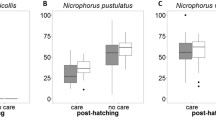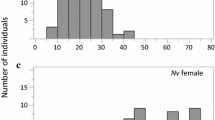Summary
Female burying beetles Necrophorus vespilloides Herbst (Coleoptera: Silphidae) were allowed to lay eggs on a carcass and their subsequent behavior towards larvae added to the carcass was observed. Females did not discriminate against unrelated larvae if these were added within an hour after the females' own first larva had hatched (at the “right” time). Changing the spatial surroundings of the carcass had no effect on the females' readiness to exhibit care behavior. Neither did the age of the larvae added or the condition of the carcass affect the onset of maternal care. However, the females' response to larvae encountered was strongly time-dependent: most females killed and ate larvae that could not have hatched from their own eggs because they were added long before their own larvae hatched. The proportion of females accepting larvae added “to early” increased as the time their own larvae hatched approached. Larvae added to the carcass 2 or 3 days after the test females' own first larva had hatched were always accepted by females that had already started to feed larvae, but were often killed by females that were not feeding larvae. In the latter group of females, the tendency to kill larvae added was most pronounced if the females had already started to produce a second clutch of eggs at the time larvae were added.
Similar content being viewed by others
References
Bartlett J (1987) Filial cannibalism in burying beetles. Behav Ecol Sociobiol 21:179–183
Bartlett J (1988) Male mating success and paternal care in Nicrophorus vespilloides (Coleoptera: Silphidae). Behav Ecol Sociobiol 23:297–303
Bartlett J, Ashworth CM (1988) Brood size and fitness in Nicrophorus vespilloides (Coleoptera: Silphidae). Behav Ecol Sociobiol 22:429–434
Byers JA, Bekoff M (1986) What does “kin recognition” mean? Ethology 72:342–345
Dawkins R (1979) Twelve misunderstandings of kin selection. Z Tierpsychol 51:184–200
Eggert AK, Müller JK (1989) Uni- and biparental care in the burying beetle, Necrophorus vespilloides. Verh Dtsch Zool Ges 82:318
Emlen ST, Wrege PH (1986) Forced copulations and intra-specific parasitism: two costs of social living in the white-fronted bee-eater. Ethology 71:2–29
Evans PGH (1988) Intraspecific nest parasitism in the European starling Sturnus vulgaris. Anim Behav 36:1282–1294
Fabre JH (1899) Souvenirs Entomologiques. Authorized translation: Bilder aus der Insektenwelt. Kosmos, Stuttgart
Fletcher DJC, Michener CD (eds) (1987) Kin recognition in animals. Wiley, New York
Hamilton WD (1964) The genetical evolution of social behavior. II. J Theor Biol 7:17–52
Hepper PG (1986) Kin recognition: functions and mechanisms. A review. Biol Rev 61:63–93
Holmes WG, Sherman PW (1983) Kin recognition in animals. Am Sci 71:46–55
Labov JB, Huck UW, Elwood RW, Brooks RJ (1985) Current problems in the study of infanticidal behavior of rodents. Q Rev Biol 60:1–20
Linsenmair KE (1984) Comparative studies on the social behavior of the desert isopod Hemilepistus reaumuri and of a Porcellio species. Symp Zool Soc London 53:423–453
Linsenmair KE (1987) Kin recognition in subsocial arthropods, in particular in the desert isopod Hemilepistus reaumuri. In: Fletcher DJC, Michener CD (eds) Kin recognition in animals. Wiley, New York, pp 121–208
Milne LJ, Milne MJ (1976) The social behavior of burying beetles. Sci Am 235:84–90
Mrowka W (1982) Untersuchungen zum Entstehen der Brutpflegebereitschaft des Kleinen Maulbrüters Pseudocrenilabrus multicolor (Cichlidae, Pisces). Z Tierpsychol 58:1–24
Müller JK (1987) Replacement of a lost clutch: a strategy for optimal resource utilization in Necrophorus vespilloides (Coleoptera: Silphidae). Ethology 76:74–80
Müller JK, Eggert A-K (1988) Biologie und Fortpflanzungsverhalten des Totengräbers Necrophorus vespilloides. Sitzungsberichte der Gesellschaft Naturforschender Freunde zu Berlin (NF) 28:31–43
Müller JK, Eggert A-K, Dressel J (1990) Intraspecific brood parasitism in the burying beetle, Necrophorus vespilloides (Coleoptera: Silphidae). Anim Behav (in press)
Mumme RL, Koenig WD, Pitelka FA (1983) Reproductive competition in the communal acorn woodpecker: sisters destroy each other's eggs. Nature 306:583–584
Pukowski E (1983) Ökologische Untersuchungen an Necrophorus F. Z Morphol Oekol Tiere 27:518–586
Scott MP (1990) Brood guarding and the evolution of male parental care in burying beetles. Behav Ecol Sociobiol 26:31–39
Stouffer PC Kennedy ED, Power HW (1987) Recognition and removal of intraspecific parasite eggs by starlings. Anim Behav 35:1583–84
Trumbo ST (1990) Interference competition among burying beetles (Silphidae, Nicrophorus). Ecol Entomol (in press)
Vehrencamp SL (1977) Relative fecundity and parental effort in communally nesting anis, Crotophaga sulcirostris. Science 197:403–405
Waldman B (1987) Mechanisms of kin recognition. J Theor Biol 128:159–185
Waldman B (1988) The ecology of kin recognition. Annu Rev Ecol Syst 19:543–571
Waldman B, Frumhoff PC, Sherman PW (1988) Problems of kin recognition. Trends Ecol Evol 3:8–13
Wilson DS, Fudge J (1984) Burying beetles: intraspecific interactions and reproductive success in the field. Ecol Entomol 9:195–203
Wilson DS, Knollenberg WG, Fudge J (1984) Species packing and temperature dependent competition among burying beetles (Silphidae, Nicrophorus). Ecol Entomol 9:205–216
Author information
Authors and Affiliations
Additional information
Offprint requests to: J.K. Müller
Rights and permissions
About this article
Cite this article
Müller, J.K., Eggert, AK. Time-dependent shifts between infanticidal and parental behavior in female burying beetles a mechanism of indirect mother-offspring recognition. Behav Ecol Sociobiol 27, 11–16 (1990). https://doi.org/10.1007/BF00183307
Received:
Accepted:
Issue Date:
DOI: https://doi.org/10.1007/BF00183307




